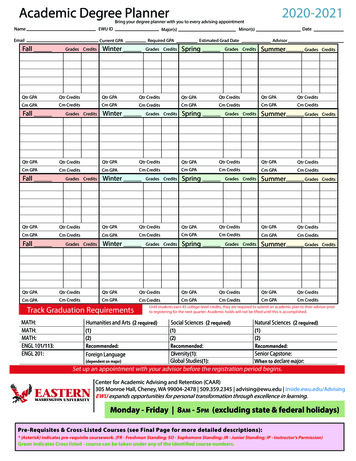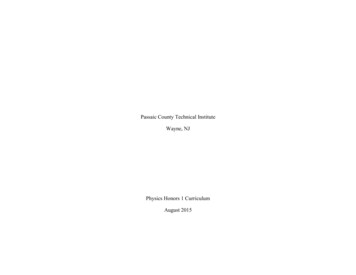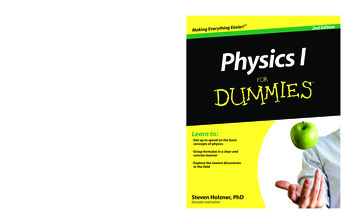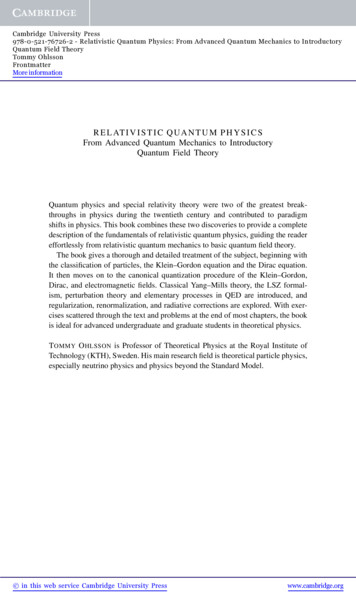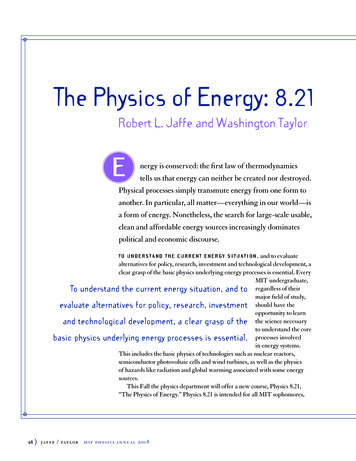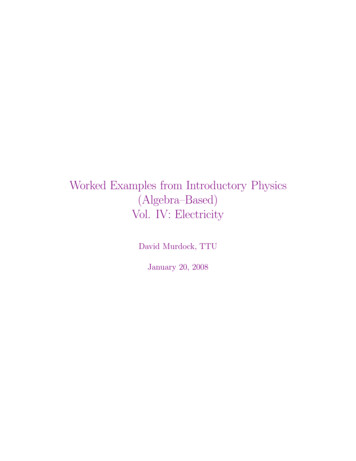
Transcription
Worked Examples from Introductory Physics(Algebra–Based)Vol. IV: ElectricityDavid Murdock, TTUJanuary 20, 2008
2
Contents1 Electric Charge and Coulomb’s Law1.1 The Important Stuff . . . . . . . . . . . .1.1.1 Electric Charge . . . . . . . . . . .1.1.2 Some Facts About Electric Charge1.1.3 Coulomb’s Law . . . . . . . . . . .1.2 Worked Examples . . . . . . . . . . . . . .1.2.1 Electric Charge . . . . . . . . . . .1.2.2 Coulomb’s Law . . . . . . . . . . .2 The Electric Field2.1 The Important Stuff . . . . . . . . . . . . . . . .2.1.1 The Electric Field . . . . . . . . . . . . . .2.1.2 Finding the Electric Field . . . . . . . . .2.1.3 Continuous Distributions; Sheets of Charge2.1.4 Electric Field Lines . . . . . . . . . . . . .2.1.5 Conductors . . . . . . . . . . . . . . . . .2.2 Worked Examples . . . . . . . . . . . . . . . . . .2.2.1 The Electric Field . . . . . . . . . . . . . .2.2.2 Finding the Electric Field . . . . . . . . .11112334.111111121314161616203 Electric Potential Energy; Electric Potential3.1 The Important Stuff . . . . . . . . . . . . . . . . . . .3.1.1 Electric Potential Energy and Electric Potential3.1.2 Calculating the Electric Potential . . . . . . . .3.1.3 Equipotentials; Relation Between E and V . . .3.1.4 Capacitance . . . . . . . . . . . . . . . . . . . .3.1.5 Dielectrics . . . . . . . . . . . . . . . . . . . . .3.1.6 Capacitors and Energy . . . . . . . . . . . . . .3.2 Worked Examples . . . . . . . . . . . . . . . . . . . . .3.2.1 Electric Potential Energy and Electric Potential.252525272830313132323.
4CONTENTS3.2.23.2.33.2.43.2.5Calculating the Electric PotentialCapacitance . . . . . . . . . . . .Dielectrics . . . . . . . . . . . . .Capacitors and Energy . . . . . .333536374 Electric Current and Resistance4.1 The Important Stuff . . . . . . . . . . .4.1.1 Electric Current . . . . . . . . . .4.1.2 Ohm’s Law . . . . . . . . . . . .4.1.3 Resistance and Resistivity . . . .4.1.4 Electric Power . . . . . . . . . . .4.1.5 Series and Parallel Circuits . . . .4.1.6 Kirchhoff’s Rules . . . . . . . . .4.2 Worked Examples . . . . . . . . . . . . .4.2.1 Electric Current . . . . . . . . . .4.2.2 Ohm’s Law . . . . . . . . . . . .4.2.3 Resistance and Resistivity . . . .4.2.4 Electric Power . . . . . . . . . . .4.2.5 Resistors in Series and in Parallel.3939394041414244444445454747
Chapter 1Electric Charge and Coulomb’s Law1.11.1.1The Important StuffElectric ChargeIn the latter part of the 18th century it was realized that any sample of matter has a propertywhich is as fundamental as its mass. This property is the electric charge of the sample.Electric charge can be detected because it gives rise to electric forces. The reason that wedon’t see electric phenomena more often than we do is that electric charges come in twotypes —positive and negative— and usually the two types occur in equal numbers so thatthey add to give zero net charge. But when we can separate positive and negative chargeswe observe electric forces on a large scale.In the SI system, electric charge is measured in Coulombs. Throughout our study ofelectromagnetism we will derive other electrical units based on the Coulomb and the unitsalready encountered in mechanics.After decades of study of the electrical properties of matter, it was found that the fundamental charges in nature occur in integer multiples of the elementary charge e,e 1.602 10 19 C(1.1)In discussing this property of charge we often say that electric charge is quantized.In the atom, the nucleus has a charge which is a multiple of e while the orbiting electronseach have a charge of e. The charge of the nucleus comes from the constituent protons,each of which has a charge of e; the neutrons in the nucleus have no charge.1.1.2Some Facts About Electric ChargeElectric charges can be separated by rubbing, as when you rub a plastic rod with someroadkill; see Fig. 1.1. Then one of the objects will obtain a positive charge and the other1
2CHAPTER 1. ELECTRIC CHARGE AND COULOMB’S LAW- - -Figure 1.1: Roadkill: Good for separating charges and mighty good eatin’.Fq1q2Fq1F Frr(a)(b)q2Figure 1.2: (a) Charges q1 and q2 have the same sign; the mutual force is repulsive. (b) Charges q1 and q2have opposite signs; the mutual force is attractive.a negative charge. This occurs because the negatively–charged electrons are removed fromone object and deposited on the other.It has been found that in an isolated system the total amount of charge stays the same,i.e. total electric charge is conserved .It is also found that electric charges of the same sign (i.e. both positive or both negative)will repel and electric charges of opposite sign (i.e. one positive and one negative) will attract.In understanding the behavior of charged objects it is important to understand howcharges can move through them. To this end we distinguish objects as being either conductors or insulators. Excess charge can move freely through a conductor and since likecharges repel one another, the charges on a charged conductor will generally move aroundto space themselves out as much as possible.In contrast, for insulators excess charge cannot move freely and generally will stay whereit is placed.1.1.3Coulomb’s LawThe force between two small (point) charges is directed along the line which joins the twocharges and is repulsive for two charges of the same sign, attractive for two charges ofthe opposite sign. (See Fig. 1.2. It is proportional to the size of either one of the two
31.2. WORKED EXAMPLEScharges; finally, it gets weaker as the distance between the charges increases. But the forceis not inversely proportional to the distance, it is inversely proportional to the square of thedistance.The law for the magnitude of the electric force between two small charges q1 and q2separated by a distance r isF k q1 q2 r2wherek 8.99 109N·m2C2(1.2)This is usually called Coulomb’s law.The constant k will come up often in our examples but later on it will be easier to workwith the constant 0, which is related to k byk so that 0 has the value 0 14π 01 8.85 10 124πkC2N·m2(1.3)The electric force given by Coulomb’s law is similar to Newton’s law for the gravitationalforce (from first semeseter) in that both are inverse–square laws; the force is inverselyproportional to the square of the distance between the particles.If we plug some easy numbers into Eq. 1.2 we find that if two 1.0 C charges are separatedby a meter, then each one experiences a repulsive force of about 9.0 109 N, which is anenormous force. In this sense, 1 C is a huge amount of charge; typically the charges whichone would encounter in real life are of the order of µC (10 6 C) or nC (10 9 C).When a charge Q is in the vicinity of several other charges (q1, q2 , etc.) the net force onQ is found by adding up the individual forces from the other charges. Of course, this is avector sum of the forces.1.21.2.1Worked ExamplesElectric Charge1. How many electrons must you have to get a total charge of 1.0 C? How manymoles of electrons is this?
4CHAPTER 1. ELECTRIC CHARGE AND COULOMB’S LAWSince each electron has a charge of 1.6 10 19 C, the number of electrons required isN ( 1.0 C) 6.2 1018( 1.6 10 19 C)A mole of any kind of particle is NAvo 6.02 1023 (Avogadro’s number) of thoseparticles. Here we have 6.2 1018 electrons and that isn (6.2 1018 )N 1.04 10 5 moles23NAvo(6.02 10 )2. A metal sphere has a charge of 8.0 µC. What is the net charge after 6.0 1013electrons have been placed on it? [CJ6 15-2]The total charge of 6.0 1013 electrons isQelec (6.0 1013 )( e) (6.0 1013 )( 1.60 10 19 C) 9.6 10 6 C 9.6 µCAfter this charge has been added to the metal sphere its total charge isQsph 8.0 µC 9.6 µC 1.6 µC1.2.2Coulomb’s Law3. A charge of 4.5 10 9 C is located 3.2 m from a charge of 2.8 10 9 C. Findthe electrostatic force exerted by one charge on another. [SF7 15-1]This will be a force of attraction between the two charges since they are of opposite signs.The magnitude of this force is given by Coulomb’s law, Eq. 1.2,F k q1q2 r2 (8.99 2 (4.5109 N·m)C2 10 9 C)(2.8 10 9 C) 1.1 10 8 N2(3.2 m)The charges will attract one another with a force of magnitude 1.1 10 8 N.4. An alpha particle (charge 2.0e) is sent at high speed toward a gold nucleus(charge 79e). What is the electrical force acting on the alpha particle when itis 2.0 10 14 m from the gold nucleus? [SF7 15-3]
51.2. WORKED EXAMPLESHere both particles are positively charged so there is a force of repulsion between them.The magnitude of this force of repulsion is given by Coulomb’s law, q1q2 (2.0)e(79.0)e k2rr2 19C)22 (2.0)(79.0)(1.6 10) (8.99 109 N·m 91.1 NC2(2.0 10 14 m)2F kSo the alpha particle experiences a (repulsive) force of 91 N from the gold nucleus.5. Two identical conducting spheres are placed with their centers 0.30 m apart.One is given a charge of 12 10 9 C, the other a charge of 18 10 9 C. (a) Findthe electrostatic force exerted on one sphere by the other. (b) The spheres areconnected by a conducting wire. Find the electrostatic force between the twoafter equilibrium is reached. [SF7 15-9](a) Use Coulomb’s law to find the magnitude of the force, which in this case is attractivesince the spheres are oppositely charged:F k q1q2 (8.99 109r2N·m2 (12)C2 10 9 C)(18 10 9 C) 2.16 10 5 N(0.30 m)2(b) When the (conducting) spheres are connect by a (thin!) conducting wire, the electriccharges are free to move between the spheres. The total charge on both spheres isQTot 12 10 9 C 18 10 9 C 6.0 10 9 Cand when this charge is free to move between the spheres it will attain an equilibrium whenboth spheres have the same charge. So after the spheres are connected the charge of each isQ QTot /2 3.0 10 9 CThis is shown in Fig. 1.3.With the new charges on the spheres, use Coulomb’s law to get the magnitude of theforce on each:F k q1q2 (8.99 109r2N·m2 (3.0)C2 10 9 C)(3.0 10 9 C) 8.99 10 7 N(0.30 m)2and now the force is repulsive since both spheres are both negatively charged.6. Three charges are arranged as shown in Fig. 1.4. Find the magnitude and
6CHAPTER 1. ELECTRIC CHARGE AND COULOMB’S LAW12 x 10-9 C-3.0 x 10-9 C-18 x 10-9 C-3.0 x 10-9 C(b)(a)Figure 1.3: (a) Conducting spheres are given different charges. (b) Charges on the spheres after beingjoined by a conducting wire.y5.00 nC6.00 nC0.300 mx0.100 m-3.00 nCFigure 1.4: Charges in Example 6direction of the electrostatic force on the charge at the origin.[SF7 15-11]Let’s call the 6.00 nC charge q1 and the 3.00 nC charge q2. (The charge at the origin isQ 5.00 nC.)The force from q1 is repulsive and points to the right. The force from q2 is attractive andpoints downward, as shown in Fig. 1.5. We need to find the magnitudes of F1 and F2 andthen add those two force vectors.From Coulomb’s law we get the magnitude of F1 ; since charge q1 is at a distance r1 F15.00 nCQF2FnetFigure 1.5: Forces on Q in Example 6
71.2. WORKED EXAMPLES0.300 m from Q,F1 k Qq1 r12 (8.99 109N·m2 (5.00)C2 10 9 C)(6.00 10 9 C) 3.00 10 6 N2(0.300 m)Likewise, the magnitude of F2 isF2 k Qq2 r22 (8.99 109N·m2 (5.00)C2 10 9 C)(3.00 10 9 C) 1.35 10 5 N(0.100 m)2Then the total force on Q has the componentsFx 3.00 10 6 NFy 1.35 10 5 NWhat is the magnitude and direction of this vector? Its magnitude isF q( 3.00 10 6 N)2 ( 1.35 10 5 N)2 1.38 10 5 Nand the direction we can find fromθ tan 1( 1.35 10 5 ) 77.5 180 103 ( 3.00 10 6 )(Note, we subtract 180 from the simple answer because the direction of the force is in thethird quadrant.)The net force on Q has magnitude 1.38 10 5 N and points at an angle of 103 fromthe x axis.7. Two small metallic spheres, each of mass 0.20 g are suspended as pendulumsby light strings from a common point as shown in Fig. 1.6. The spheres are giventhe same electric charge and it is found that they come to equilibrium when eachstring is at an angle of 5.0 with the vertical. If each string is 30.0 cm long, whatis the magnitude of the charge on each sphere? [SF7 15-15]From simple trig we can calculate the distance between the two spheres. If this distanceis x, thenx 2(30.0 m) sin 5.0 5.23 cm 5.23 10 2 m
8CHAPTER 1. ELECTRIC CHARGE AND COULOMB’S LAWqq30.0 cm30.0 cm0.20 g0.20 gFigure 1.6: Suspended charged spheres in Example 75.0o5.0oTFelecxmgFigure 1.7: Forces acting on a charged sphere in Example 7
91.2. WORKED EXAMPLESNow consider the forces acting on one of the spheres, say the one on the right. These areshown in Fig. 1.7, where we also note (for reference) the location of other sphere. The rightsphere experiences a force of electric repulsion from the left sphere. The forces are the forceof gravity (mg, downward), the tension of the string (magnitude T ; it pulls at an angle 5.0 from the vertical) and the electric repulsive force. From Coulomb’s law, the magnitude ofthe latter isq2Felec k 2xwhere q is the magnitude of the charge on each sphere.The sphere is in equilibrium, so the forces must sum to zero. The vertical forces cancelout, giving us:T cos 5.0 mg (2.00 10 4 kg)(9.80 sm2 )mgT 1.97 10 3 N cos 5.0cos 5.0The horizontal forces cancel out and this gives:T sin 5.0 Felec kq2x2which lets us solve for q:q2 T x2 sin 5.0 (1.97 10 3 N)(5.23 10 2 )2 sin 5.0 5.22 10 17 C2 2k(8.99 109 N·m)C2so thenq 7.2 10 9 C 7.2 nC
10CHAPTER 1. ELECTRIC CHARGE AND COULOMB’S LAW
Chapter 2The Electric Field2.12.1.1The Important StuffThe Electric FieldWhen we solved the longer Coulomb Law problems in the previous chapter we added up the(vector) forces from charges q1, q2, . . . acting on a certain charge Q. Now, each one of theseindividual forces (and hence the sum of those forces) is proportional to the charge Q. If ineach of those problems we divided the net force by the charge Q we would get a force perunit charge at the location of Q. This quantity (which is a vector, since force is a vector)would depend on the values and locations of the charges q1, q2 . . . This idea is representedin Fig. 2.1.So, a given configuration of charges q1 , q2 . . . gives rise to an electric field E such thatthe force on a charge Q is given byF QE .(2.1)q1q1q2q2Qq3q3FE F/Q(b)(a)Figure 2.1: (a) Charge Q experiences a force F from the charges q1, q2 . . . (b) The quantity E F/Qdepends only on the charges q1 , q2 . . .11
12CHAPTER 2. THE ELECTRIC FIELDqqrEPPE(a)(b)Figure 2.2: (a) Point P is a distance r away from charge q. If q is positive, the electric field points awayfrom q. (b) If q is negative, the electric field points toward q. In both cases the magnitude of E is given byE k q /r 2 .When we use this equation we mean that after we put Q in place all the little chargesq1, q2 . . . are in the same places they were when we deduced the value of E from their valuesand positions! This will be true in practice if the “test charge” Q is small. Thus we give apractical definition of the E field asE FQwhere Q is a small charge(2.2)From Eq. 2.2 we see that the electric field is a vector and has units of N/C.We note that finding the electric field is more useful than finding the force on a specificcharge since once we have the E field we simply multiply by the charge Q to get the force,as given by Eq. 2.1.2.1.2Finding the Electric FieldIt follows from Coulomb’s law that at a point which is a distance r from a point charge q,the magnitude of the electric field isEpt ch k q r2(2.3)and the direction of the field is away from q if q is positive and toward q if q is negative.This is shown in Fig. 2.2.When we need to find the electric field due a collection of point charges we find theelectric field due to each charge and then find the (vector) sum.
132.1. THE IMPORTANT STUFFEPzFigure 2.3: Point P is at some distance z above an infinte plane of charge with charge density σ. If σ ispositive the E field points away from the sheet and has magnitude σ/(2 0 ).2.1.3Continuous Distributions; Sheets of ChargeMany charged objects we encounter are not sets of points charges; rather they are continuousdistributions of charge. If a two-dimensional region of space contains a charge we can talkabout its charge per unit area, or surface charge density.Surface charge density is usually given the symbol σ; it has units of C/m2 .The simplest case of a surface charge is that of an infinite planar sheet of charge withuniform charge density σ. We want to know the value of the electric field E at a point Pwhich is a distance z from the plane; see Fig. 2.3.It turns out that the answer does not depend on z. If σ is positive, the electric field atP points away from the sheet and has magnitudeσ.(2.4)Einf sh 2 0Here it is easiest to express the result using the constant 0 introduced in Eq. 1.3If the sheet has a negative charge density then the field points toward the sheet and themagnitude of the field is E σ /(2 0).Next we take the case of the two very large, flat, parallel sheets of charge, as shown inFig. 2.4. A total charge of Q has been placed on one sheet and a charge of Q on theother. We assumed the charge is spread around uniformly so that the charge density of thepositively-charge sheet is σ Q.AThis situation can arise when equal and opposite charges are placed on metal plates whichare held apart at some distance. (Such a device is called a parallel–plate capacitor.) Ourapproximation is suitable for the case where the plates are separated by a distance which issmall compared with the linear size of the plates.From Eq. 2.4 it follows that the magnitude of the E field between the plates is twice thatof the single sheet,σQEinf sh .(2.5) 0 0 A
14CHAPTER 2. THE ELECTRIC FIELD-Q, AEP Q, AFigure 2.4: Point P is between two very large sheets of charge. On one sheet the total charge is Q andon the other it is Q. Both sheets have area A. With σ Q/A, the electric field between the plates hasmagnitude σ/ 0 .and the field points from the positive plate to the negative plate.This equation gives the E field anywhere between the plates and it is good as long wecan approximate the plates as “very large”. Near the edges of the plates it is not a verygood approximation.2.1.4Electric Field LinesWhile the direction of the electric field near a point charge or between two large plates has asimple answer, most charge distributions produce electric fields dependence on position canbe hard to visualize.To help in seeing the direction of the electric at all points we imagine finding the directionof the electric field at all points in space, represented by a little arrow at any point. Then ifwe join nearby arrows together to form a curve we get an electric field line. This is shownin Fig. 2.5 for a (positive) point charge; the field lines start on the charge and go outward.(For a negative charge the field lines would go inward to the charge.)An interesting and important configuration of charges is the electric dipole which consists of two opposite charges q separated by a distance which is usually taken to be “small”in some sense. Near the charge q the electric field points mainly away from the chargeand near the charge q the field points mainly toward the charge. At other points in spacewe have to form the sum of the field from the two charges and add. The result is shown inFig. 2.6.The mathematics of the electric force gives the following properties of field lines: Field lines begin and end only on charges; they start on positive charges and end onnegative charges. Field lines cannot cross one another.Field lines give us the direction of the electric field at any point, but since we have joinedthe arrows togther to form them, a single field line can’t tell the magnitude of the E field.
152.1. THE IMPORTANT STUFF q q(b)(a)Figure 2.5: (a) A representation of the electric field around a point charge using individual vectors. (b)Representation of the electric field around a point charge using field lines. q-qFigure 2.6: Field lines of an electric dipole.
16CHAPTER 2. THE ELECTRIC FIELDFelec qEqmFgrav mgFigure 2.7: Forces on the charged mass in Example 1. The electric force is upward (in the same directionas the E field). The force of gravity is downward.But the mathematics of the electric force tell us that the number of field lines that we draworiginating on a charge should be proportional the the size of the charge. If we follow thatrule, then the magnitude of the electric field can be judged from the density of field lines atany point. If the lines are closely space, the electric field is strong at that place.2.1.5ConductorsIn conductors any excess charge is free to move through the material.2.22.2.1Worked ExamplesThe Electric Field1. An object with a net charge of 24 µC is placed in a uniform electric field of610 N, directed vertically. What is the mass of the object if it “floats” in theCelectric field? [SF7 15-17]The forces acting on this object (of mass m and charge q are shown in Fig. 2.7. Theforce of gravity has magnitude mg and points downward. The electric force, from Eq. 2.1has magnitude qE and points upward. (Here the charge q is positive so that the force pointsin the same direction as the E field.)The object ”floats” so the net force on it must be zero. Hence:qE mg m qEg
172.2. WORKED EXAMPLESE 1.00 x 103 N/C15.0o20.0 cmm 2.00 gFigure 2.8: Plastic ball suspended in uniform E field, in Example 3.Plug in the numbers:(24 10 6 C)(610 N)C 1.5 10 3 kgm m(9.80 s2 )So the mass of the object is 1.5 grams.Npoints due west at a certain spot. What are the2. An electric field of 260000 Cmagnitude and direction of the force that acts on a charge of 7.0 µC at thisspot? [CJ6 18-25]From F qE, the magnitude of the force isF q E (7.0 µC)(260000 N) (7.0 10 6 C)(2.60 105 N) 1.8 NCCSince the charge q is negative here, the direction of the force is opposite that of the field E,so the force points to the East.3. A small 2.00-g plastic ball is suspended by a 20.0-cm -long string in a uniformelectric field, as shown in Fig. 2.8. If the ball is in equilibrium when the stringmakes a 15.0 angle with the vertical as indicated, what is the net charge on theball? [SF7 15-50]First, make a free–body diagram of the forces acting on the ball. They are: The stringtension T directed along the string; the force of gravity, mg, downward; and the electricforce which must be parallel to the electric and so here it must point to the right. Theseforces are shown in Fig. 2.9. The magnitude of the electric force is qE, where q is the chargeon the plastic ball; this charge must be positive since the force points in the same direction
18CHAPTER 2. THE ELECTRIC FIELDo15.0o 15.0m 2.00 gFelec qETFelecmgFigure 2.9: Forces acting on the plastic ball in Example 3.as E. The ball is in equilibrium so the (vector) sum of the forces is zero. The condition thatthe vertical force components sum to zero allows us to find T :T cos 15.0 mg 0 (2.00 10 3 kg)(9.80 sm2 )mg 2.03 10 2 NT cos 15.0(cos 15.0 ) The condition that the horizontal forces sum to zero gives us: T sin 15 Felec T sin 15 qE 0 q T sin 15 EPlug in the numbers and get:q (2.03 10 2 N) sin 15 5.25 10 6 C 5.25 µCN 3(1.00 10 C )4. Each of the protons in a particle beam has a kinetic energy of 3.25 10 15 J.What are the magnitude and direction of the electric field that will stop theseprotons in a distance of 1.25 m? [SF7 15-22]First, use the proton mass and definition of kinetic to find the initial speed of theseprotons. With mp 1.67 10 27 kg, we find:KE 1m v22 p 3.25 10 15J 2(3.25 10 15 J)v 3.89 1012 27(1.67 10 kg)2Then:v 1.97 106msm2s2
192.2. WORKED EXAMPLESv 1.97 x 106 m/sv 0 e1.25 mFigure 2.10: Proton slows to a halt in Example 4.The motion of the proton is as shown in Fig. 2.10. Using our equations of kinematics,we can find the acceleration of the proton:2v v02 2ax 0 (1.97 106v 2 v02 a 2x2(1.25 m)m 2)s 1.56 1012ms2which should be negative since the proton’s velocity decreases.The force on the proton comes from the electric field, as given by Eq. 2.1:Fx max qEx eExwhere we’ve used the fact that a proton’s charge is e. Then:Ex (1.67 10 27 kg)( 1.56 1012max e(1.60 10 19 C)The electric field has magnitude 1.62 104the initial motion of the proton.NCm)s2 1.62 104NCand points in the x direction, that is, opposite5. A proton accelerates from rest in a uniform electric field of 640 N. At someC6 mtime, its speed is 1.20 10 s . (a) Find the magnitude of the acceleration of theproton. (b) How long does it take the proton to reach this speed? (c) How farhas it moved in that interval? (d) What is its kinetic energy at the later time?[SF7 15-23](a) The facts given in the problem are diagrammed in Fig. 2.11. If the E field points inthe x direction, then from Eq. 2.1 the force on the proton isFx qEx eExand the acceleration of the proton isax FxeEx mpmp
20CHAPTER 2. THE ELECTRIC FIELDv 0v 1.20 x 106 m/sE e eEEFigure 2.11: Proton is accelerated by E field in Example 5.Use mp 1.67 10 27 kg and get:ax (1.60 10 19 C)(640 N)C 6.13 1010 27(1.67 10 kg)ms2(b) We have the (constant) acceleration of the proton and its initial and final speeds sousing one of our equations from kinematics we can find the distance it traveled:2vx2 v0x 2ax xPlug in the numbers: x 2(vx2 v0x)2ax(1.20 106 ms )2 0x 11.7 m2(6.13 1010 sm2 )(c) Use the definition of kinetic energy, KE 12 mv 2 and get:KE 21 (1.67 10 27 kg)(1.20 106 )2 1.20 10 15 J2.2.2Finding the Electric Field6. Three point charges are aligned along the x-axis as shown in Fig. 2.12. Findthe electric field at the position x 2.0 m, y 0. [SF7 15-49]The point at which we want to calculate the E field, (2.0 m, 0), lies to the right of allthe charges. At that point, the field due to the 4.0 nC charge must point to the left sinceit is a negative charge. That charge lies at a distance of 2.50 m from So x-component of itscontribution isE1,x k q1 (8.99 109r12N·m2 (4.0)C2 10 9 C) 5.75 NC(2.50 m)2
212.2. WORKED EXAMPLESy2.00 m0.50 m-4.0 nC0.80 m5.0 nCx3.0 nCFigure 2.12: Configuration of charges for Example 6.1.0 m-2.5 mC6.0 mCFigure 2.13: Configuration of charges for Example 7.The field due to the charge at the origin must point to the right since it is a positivecharge. The x-component of its contribution isE2,x k q2 (8.99 109r22N·m2 (5.0)C2 10 9 C) 11.2 NC(2.00 m)2Finally, the field due to the 3.0 nC charge must also point to the right since it is a positivecharge. This charge’s distance from our “observation” point is 1.20 m, so the x-componentof its contribution isE3,x k q3 (8.99 109r32N·m2 (3.0)C2 10 9 C) 18.7 NC(1.20 m)2Add these up, and the total E field at the given point isNEx 5.75 C 11.2 N 18.7 N 24.1 NCCC7. In Fig. 2.13, determine the point (other than infinity) at which the totalelectric field is zero. [SF7 15-27]For all points that we consider there will be a (vector) electric field due to the 2.5 µCcharge and one due to the 6.0 µC charge; we want to find the point at which these vectorsadd to zero.It would seem that this point should lie on the line joining the two charges, but do weneed to consider points off this line? No, because at points off this axis the two field vectors
22CHAPTER 2. THE ELECTRIC FIELDwill point toward or away from the individual charges and at points off the axis those vectorscan’t be parallel and so can’t cancel. So we only need to think about points on the axis.Could this point lie between the two charges? In that region, the field due to the 2.5 µCcharge will point toward that charge (i.e. to the left) and that due to the 6.0 µC chargewill point away from that charge (i.e. also to the left). Those vectors can’t cancel regardlessof their magnitudes, so the point can’t lie between the two charges.How about someplace to the right of both charges? In that region, the 6.0 µC chargeis always closer than the 2.5 µC charge. That being the case, the field from the 6.0 µCcharge must always have the larger magnitude (charge is bigger and distance is smaller) soagain the vectors can’t cancel.The point we want must lie to the left of both charges. In that region, the field due tothe 2.5 µC charge points to the right and that due to the 6.0 µC charge points to theleft. (Note that the 2.5 µC charge is always closer and since it also has a smaller charge,there could be some place where the fields cancel.) If we consider a point which lies at adistance d to the left of the 2.5 µC charge, then its distance from the 6.0 µC charge willbe d 1.0 m, and using Eq. 2.3 the x component of the total field will beEx,total k( 2.5 µC)(6.0 µC) k 02d(d 1.0 m)2(2.6)It is now just a math problem to solve for d. We’re done with the physics.First off, we can cancel the constant k in Eq. 2.6 as well as the “ µC” units. One trickthat will work (unless you’ve got any better ideas!) is to multiply both sides of Eq. 2.6 byd2 (d 1.0 m)2 . That gives us:d2 (d 1.0 m)2( 2.5)(6.0) d2 (d 1.0 m)2 02d(d 1.0 m)2Cancel things and get:(d 1.0 m)2 (2.5) d2 (6.0
1.2.2 Coulomb's Law 3. A charge of 4.5 10 9 C is located 3.2m from a charge of 2.8 10 9 C. Find the electrostatic force exerted by one charge on another. [SF7 15-1] This will be a force of attraction between the two charges since they are of opposite signs. The magnitude of this force is given by Coulomb's law, Eq. 1.2, F k .
